Dynamics of Changes in Spatial Patterns of Built-Up Areas in Two Metropolitan Areas of Grand Lomé and Greater Accra (West Africa)
Abstract
1. Introduction
2. Materials and Methods
2.1. Study Area
2.2. Data Types and Sources
2.3. Data Processing Methods
2.3.1. Image Processing and Classification
2.3.2. Accuracy Assessment
2.3.3. Change Detection Analysis
2.3.4. Analysis of Urban Expansion and Sprawl
3. Results
3.1. Land Use and Land Cover Change in DAGL and GAMA
3.2. Accuracy Assessment
3.3. Urban Expansion Dynamics
- In GAMA, the result shows a high rate of built-up area expansion in the peri-urban areas, particularly towards the Nord-Est region where Kpone Katamanso, Adenta Municipal, and Tema Metropolis are located. This expansion is more pronounced in quadrant Q3 between 1991 and 2002 and in quadrant Q2 between 2002 and 2017 (Figure 7). Quadrants Q1 and Q14 recorded the highest growth rates between 2017 and 2023. The rapid urban expansion observed in quadrants Q15 and Q16 between 1986 and 2015 indicates significant peri-urbanization activity. According to Table 8 detailing the UEII for GAMA, values exceeding 1.92 were recorded in quadrants Q2, Q3, Q12, and Q13 from 1991 to 2002, indicating a very high-speed urban expansion during this period. High-speed expansions were also observed in quadrants Q15 and Q16, while medium-speed expansion occurred in quadrants Q1 and Q14. From 2002 to 2017, very high-speed expansion was noted in quadrants Q2 and Q12. High-speed expansion occurred in quadrants Q1, Q3, Q15, and Q16. Medium-speed expansion was recorded in quadrant Q14. Slow expansion was observed in quadrant Q13. From 2017 to 2023, all quadrants experienced very high-speed expansion, only quadrant Q3 demonstrated high speeds of expansion. The relative Shannon’s entropy values for GAMA range from 0.82 to 0.96 between 1991 and 2023, revealing a scattered urban region;
- Both metropolitan areas exhibited rapid urban expansion, particularly in peri-urban areas, with distinct spatial and temporal patterns. DAGL’s growth was concentrated in the northwest, while GAMA’s expansion was prominent in both the Nord-Est region and Nord-Western region. Notably, GAMA experienced widespread very high-speed expansion across nearly all quadrants from 2017 to 2023, while DAGL’s expansion was more spatially varied in the same period. The trend of rising relative Shannon’s entropy values in both DAGL and GAMA confirms increased urban fragmentation and, consequently, the evidence of urban sprawl.
4. Discussion
4.1. LULC Change Patterns in DAGL and GAMA
4.2. Spatial Patterns of Urban Expansion
4.3. Urban Sprawl
4.4. Mitigation Strategies and Policy Implications
4.5. Limitations and Future Scope
5. Conclusions
Author Contributions
Funding
Data Availability Statement
Conflicts of Interest
References
- Pande, C.B.; Moharir, K.N.; Varade, A.M.; Abdo, H.G.; Mulla, S.; Yaseen, Z.M. Intertwined impacts of urbanization and land cover change on urban climate and agriculture in Aurangabad city (MS), India using google earth engine platform. J. Clean. Prod. 2023, 422, 138541. [Google Scholar] [CrossRef]
- UN-Habitat, World Urbanization Prospects. 2018. Available online: https://population.un.org/wup/assets/WUP2018-Report.pdf (accessed on 5 November 2023).
- Ingwani, E.; Thynell, M.; Gurure, L.R.; Ekelund, N.G.A.; Gumbo, T.; Schubert, P.; Nel, V. The Impacts of Peri-Urban Expansion on Municipal and Ecosystem Services: Experiences from Makhado Biaba Town, South Africa. Urban Forum 2024, 35, 297–327. [Google Scholar] [CrossRef]
- INSEED, Résultats Définitifs du RGPH-5 (Novembre 2022). Available online: https://inseed.tg/resultats-definitifs-du-rgph-5-novembre-2022/ (accessed on 7 July 2023).
- GSS. Ghana 2021 Population and Housing Census. General Report. 2021. Available online: https://www.bing.com/search?q=Ghana+2021+Population+and+Housing+Census+General+Report+pdf (accessed on 10 January 2023).
- Cobbinah, P.B.; Asibey, M.O.; Gyedu-Pensang, Y.A. Urban land use planning in Ghana: Navigating complex coalescence of land ownership and administration. Land Use Policy 2019, 99, 105054. [Google Scholar] [CrossRef]
- Biney, E.; Boakye, E. Urban sprawl and its impact on land use land cover dynamics of Sekondi-Takoradi metropolitan assembly, Ghana. Envir. Chall. 2021, 4, 100168. [Google Scholar] [CrossRef]
- Sahalu, A.G. Analysis of Urban Land Use and Land Cover Changes: A Case Study in Bahier Dar, Ethiopia. Master’s Thesis, University of Lisbon, Lisbon, Portugal, 2014. [Google Scholar]
- Tsurusaki, N.; Salem, M. Impacts of Rapid Urban Expansion on Peri-Urban Landscapes in the Global South: Insights from Landscape Metrics in Greater Cairo. Sustainability 2024, 16, 2316. [Google Scholar] [CrossRef]
- Ahlstom, A.; Xia, J.; Arneth, A.; Luo, Y.; Smith, B. Corrigendum: Importance of vegetation dynamics for furture terrestrial carbon cycling. Environ. Res. Lett. 2015, 10, 13. [Google Scholar]
- Pan, X.; Zhenyi, W.; Gao, Y.; Dang, X.; Han, Y. Detailed and automated classification of land use/land cover using machine learning algorithms in Google earth Engine. Geacarto Int. 2021, 37. [Google Scholar] [CrossRef]
- Somadjago, M.; Cissokho, D.; Suka, D.K. Mutations socio-économiques et demographiques des espaces ruraux phagocytés par la ville de LOMÉ. Rev. Espac. Geogr. Soc. Marocaine 2020, 36, 27–43. [Google Scholar]
- Blakime, T.H.; Komi, K.; Adjonou, K.; Hlovor, A.K.D.; Gbafa, K.S.; Oyedele, P.B.; Polorigni, B.; Kokou, K. Dynamics of Built-Up Areas and Challenges of Planning and Development of Urban Zone of Greater Lomé in Togo, West Africa. Land 2024, 13, 84. [Google Scholar] [CrossRef]
- Takili, M.; Danvide, T.B.; Banon, F. Adétikopé, un pôle urbain émergent à Lomé: Entre dynamisme de la migration résidentielle et de la masse urbaine. Regardsuds. 2020. Available online: https://regardsuds.org/adetikope-un-pole-urbain-emergent-a-lome-entre-dynamisme-de-la-migration-residentielle-et-de-la-masse-urbaine/ (accessed on 1 November 2023).
- Amouzoukpo, K. Dynamique Residentielle, Mutations Sociospatiales et Environnementales a Agoenyive (Peripherie Nord De lome au Togo). Ph.D. Thesis, Université de Lomé, Lomé, Togo, 2021. [Google Scholar]
- Asabere, B.; Acheampong, R.A.; Ashiagbor, G.; Beckers, S.C.; KecAk, M.; Erasmi, S.; Schanze, J. Sauer, Urbanization, land use transformation and spatio-environmental impacts: Analyses of trends and implications in major metropolitan regions of Ghana. Land Use Policy 2020, 96, 104707. [Google Scholar] [CrossRef]
- Toure, S.I.; Stow, D.A.; Clarke, K.; Weeks, J. Patterns of land cover and land use change within the two major metropolitan areas of Ghana. Geocarto Int. 2020, 35, 209–223. [Google Scholar] [CrossRef]
- Addae, B.; Oppelt, N. Land-Use/Land-Cover Change Analysis and Urban Growth Modelling in the Greater Accra Metropolitan Area (GAMA), Ghana. Urban. Sci. 2019, 3, 26. [Google Scholar] [CrossRef]
- Akubia, J.E.K.; Bruns, A. Unravelling the frontiers of urban growth: Spatio-Temporal dynamics of land-use change and urban expansion in greater Accra metropolitan area, Ghana. Land 2019, 8, 131. [Google Scholar] [CrossRef]
- Puplampu, D.A.; Boafo, Y.A. Exploring the impacts of urban expansion on green spaces availability and delivery of ecosystem services in the Accra Metropolis. J. Environ. Chall. 2021, 5, 100283. [Google Scholar] [CrossRef]
- Annan, E.; Amponsah, W.; Adjei, K.A.; Disse, M.; Hounkpè, J.; Biney, E.; Agbenorhevi, A.E.; Agyare, W.A. Spatio-temporal land use and land cover change assessment: Insights from the Ouémé River Basin. Sci. Afr. 2023, 25, e02262. [Google Scholar] [CrossRef]
- Akpagana, K.; Bouehet, P. Etat actuel des connaissances sur la flore et la végétation du Togo. Acta Bot. Gall. 1994, 141, 367–372. [Google Scholar] [CrossRef]
- Kokou, K. Les Mosaïques Forestières au sud du Togo: Biodiversité, Dynamique et Activités Humaines. Ph.D. Thesis, University of Montpellier II, Montpellier, France, 1998. [Google Scholar]
- Afidégnon, D. Les Mangroves et les Formations Associées du Sud-Est du Togo: Analyse Ecofloristique et Cartographique par Télédétection Spatiale. Ph.D. Thesis, Université de Lomé, Lomé, Togo, 1999. [Google Scholar]
- de Foucault, B.; Akpagana, K.; Batawila, K.; Bouchet, P. Contribution à une étude phytosociologique du littoral sableux du Togo. Acta Bot. Gall. 2000, 147, 333–344. [Google Scholar] [CrossRef]
- Bawa, A.; Djalna, K.; Kamou, H.; Batawila, K.; Imbernon, J.; Akpagana, K. Role of Women in Maintaining Suburban Agricultural Land in Togo (West Africa). Sci. Res. 2021, 8, e8182. [Google Scholar] [CrossRef]
- Gyimah, R.R.; Antwi, R.A.; Attua, E.M.; Owusu, A.B.; Doe, E.K. Trading greens for heated surfaces: Land surface temperature and perceived health risk in Greater Accra Metropolitan Area, Ghana. Egypt. J. Remote Sens. Sp. Sci. 2023, 26, 861–880. [Google Scholar] [CrossRef]
- Olofsson, P.; Foody, G.M.; Herold, M.; Stehman, S.V.; Woodcock, C.E.; Wulder, M.A. Good practices for estimating area and assessing accuracy of land change. Remote Sens. Environ. 2014, 148, 42–57. [Google Scholar] [CrossRef]
- Loukika, K.N.; Keesara, V.R.; Sridhar, V. Analysis of land use and land cover using machine learning algorithms on google earth engine for Munneru river basin, India. Sustainability 2021, 13, 24. [Google Scholar] [CrossRef]
- Hengl, T.; Heuvelink, G.B.; Kempen, B.; Leenaars, J.G.; Walsh, M.G.; Shepherd, K.D.; Sila, A.; MacMillan, R.A.; Mendes de Jesus, J.; Tamene, L.; et al. Mapping soil properties of Africa at 250 m resolution: Random forests significantly improve current predictions. PLoS ONE 2015, 10, e0125814. [Google Scholar] [CrossRef]
- Breiman, L. Random Forests. Mach. Learn. 2001, 45, 5–32. [Google Scholar] [CrossRef]
- Belgiu, M.; Dragut, L. Random Forest in remote sensing: A review of applications and future directions. Photogramm. Remote Sens. 2016, 114, 24–31. [Google Scholar] [CrossRef]
- Mosammam, M.H.; Nia, J.T.; Khani, H.; Teymouri, A.; Kazemi, M. Monitoring land use change and measuring urban sprawl based on its spatials forms. The case of Qom city. Egypt. J. Remote Sens. Sp. Sci. 2016, 20, 103–116. [Google Scholar]
- Wiafe, E.D.; Asamoah, G. Land-cover change assessment in Ejisu-Juabeng district in Ghana. Euraian J. For. Sci. 2018, 6, 1–8. [Google Scholar] [CrossRef]
- Long, H.; Tang, G.; Li, X.; Heilig, G.K. Socio-economic driving forces of land-use change in Kunshan, the Yangtze River Delta economic area of China. Environ. Manag. 2007, 83, 351–364. [Google Scholar] [CrossRef]
- García-Álvarez, D.; Olmedo, M.T.C.; Mas, J.-F.; Paegelow, M. Land Use Cover Datasets and Validation Tools; Springer International Publishing: Berlin/Heidelberg, Germany, 2022. [Google Scholar]
- Cao, H.; Liu, J.; Chen, J.; Gao, J.; Wang, G.; Zhang, W. Spatiotemporal patterns of urban land use change in typical cities in the Greater Mekong Subregion (GMS). Remote Sens. 2019, 11, 7. [Google Scholar] [CrossRef]
- Al-Kafy; Hasan, M.M.; Islam, A.-A.-F.M.; Rahman, M.S. Modelling future land use land cover changes and their impacts on land surface temperatures in Rajshahi, Bangladesh. Remote Sens. Appl. Soc. Env. 2020, 18, 100314. [Google Scholar]
- Qian, Y.; Wu, Z. Study on urban expansion using the spatial and temporal dynamic changes in the impervious surface in Nanjing. Sustainability 2019, 11, 933. [Google Scholar] [CrossRef]
- Rahman, M.T. Land use and land cover changes and urban sprawl in riyadh, saudi arabia: An analysis using multi-temporal landsat data and shannon’ s entropy index. Int. Arch. Photogramm. Remote Sens. 2016, XLI-B8, 1017–1021. [Google Scholar] [CrossRef]
- Malligai, M.A.; Jegankumar, R. Mapping Urban Sprawl and Measuring Urban Density using Shannon Entropy: A Case Study of Salem City and its Environ. Int. J. Sci. Res. 2018, 7, 4. [Google Scholar]
- Devendran, A.A.; Banon, F. Spatio-Temporal Land Cover Analysis and the Impact of Land Cover Variability Indices on Land Surface Temperature in Greater Accra, Ghana Using Multi-Temporal Landsat Data. J. Geogr. Inf. Syst. 2022, 14, 240–258. [Google Scholar] [CrossRef]
- MoFA (Ministry of Food and Agriculture). Agriculture in Ghana 2018. Available online: https://mofa.gov.gh/site/images/pdf/AGRIC%20IN%20GHANA%20F&F_2018.pdf (accessed on 21 February 2024).
- Barman, S.; Roy, D.; Sarkar, B.C.; Almohamad, H.; Abdo, H.G. Assessment of urban growth in relation to urban sprawl using landscape metrics and Shannon’s entropy model in Jalpaiguri urban agglomeration, West Bengal, India. Geocarto Int. 2024, 39, 1. [Google Scholar] [CrossRef]
- Tessema, W.M.; Abebe, G.B. Quantification of land use/land cover dynamics and urban growth in rapidly urbanized countries: The case Hawassa city, Ethiopia. Urban. Plan. Transp. Res. 2023, 11, 1. [Google Scholar]
- Yang, Y.; Liu, Y.; Li, Y.; Du, G. Quantifying spatio-temporal patterns of urban expansion in Beijing during 1985–2013 with rural-urban development transformation. Land Use Policy. 2018, 74, 220–230. [Google Scholar] [CrossRef]
- Al-Sharif, A.A.A.; Pradhan, B.; Shafri, H.Z.M.; Mansor, S. Quantitative analysis of urban sprawl in Tripoli using Pearson’s Chi-Square statistics and urban expansion intensity index. IOP Conf. Ser. Earth Environ. Sci. 2014, 20, 1–8. [Google Scholar] [CrossRef]
- Hetcheli, F.; Dandonougbo, I.; Biakouye, A.K. Du village à l’espace périurbain: Mutations socio-économiques du canton d’adetikope, un territoire sous influence de lome (Togo). Homme Soc. 2017, 2409–9791. [Google Scholar]
- Owusu, G. Coping with Urban Sprawl: A Critical Discussion of the Urban Containment Strategy in a Developing Country City, Accra. J. Urban. 2013, 2, 17. [Google Scholar]
- Adu-Boahen, K.; Addai, M.O.; Hayford, S.C.; Adjovu, E.T.; Yeboah, D.O.; Mensah, P. Human-environment nexus: Evaluating the anthropo-geomorphology and urban expansion of the Weija Gbawe Municipality, Ghana. Discov. Environ. 2023, 1, 21. [Google Scholar] [CrossRef]
- Acheampong, R.A.; Agyemang, F.S.K.; Abdul-Fatawu, M. Quantifying the spatio-temporal patterns of settlement growth in a metropolitan region of Ghana. Geo J. 2017, 82, 823–840. [Google Scholar] [CrossRef]
- Owusu-Ansah, J.K.; Dery, J.M.; Amoako, C. Flood vulnerability and coping mechanisms around the Weija Dam near Accra, Ghana. Geo J. 2019, 84, 1597–1615. [Google Scholar] [CrossRef]
- Agyemang, F.S.K.; Amedzro, K.K.; Silva, E. The emergence of city-regions and their implications for contemporary spatial governance: Evidence from Ghana. Cities 2017, 71, 70–79. [Google Scholar] [CrossRef]
- Duan, Q.; Tan, M.; Guo, Y.; Wang, X.; Xin, L. Understanding the spatial distribution of urban forests in China using Sentinel-2 images with Google Earth Engine. Forests 2019, 10, 729. [Google Scholar] [CrossRef]
- Haldar, S.; Chatterjee, U.; Bhattacharya, S.; Paul, S.; Bindajam, A.A.; Mallick, J.; Abdo, H.G. Peri-urban dynamics: Assessing expansion patterns and influencing factors. Ecol. Process. 2024, 13, 1. [Google Scholar] [CrossRef]
- Aswal, P.; Saini, R.; Ansari, T.M. Spatio-Temporal Monitoring of Urban Sprawl using GIS and Remote Sensing Technique. Int. J. Comput. Appl. 2018, 182, 11–24. [Google Scholar] [CrossRef]
- Xu, G.; Dong, T.; Cobbinah, P.B.; Jiao, L.; Sumari, N.S.; Chai, B.; Liu, Y. Urban Expansion and Form Changes across African Cities with a Global 2 Outlook: Spatiotemporal Analysis of Urban Land Densities. J. Clean. Prod. 2019, 224, 802–810. [Google Scholar] [CrossRef]
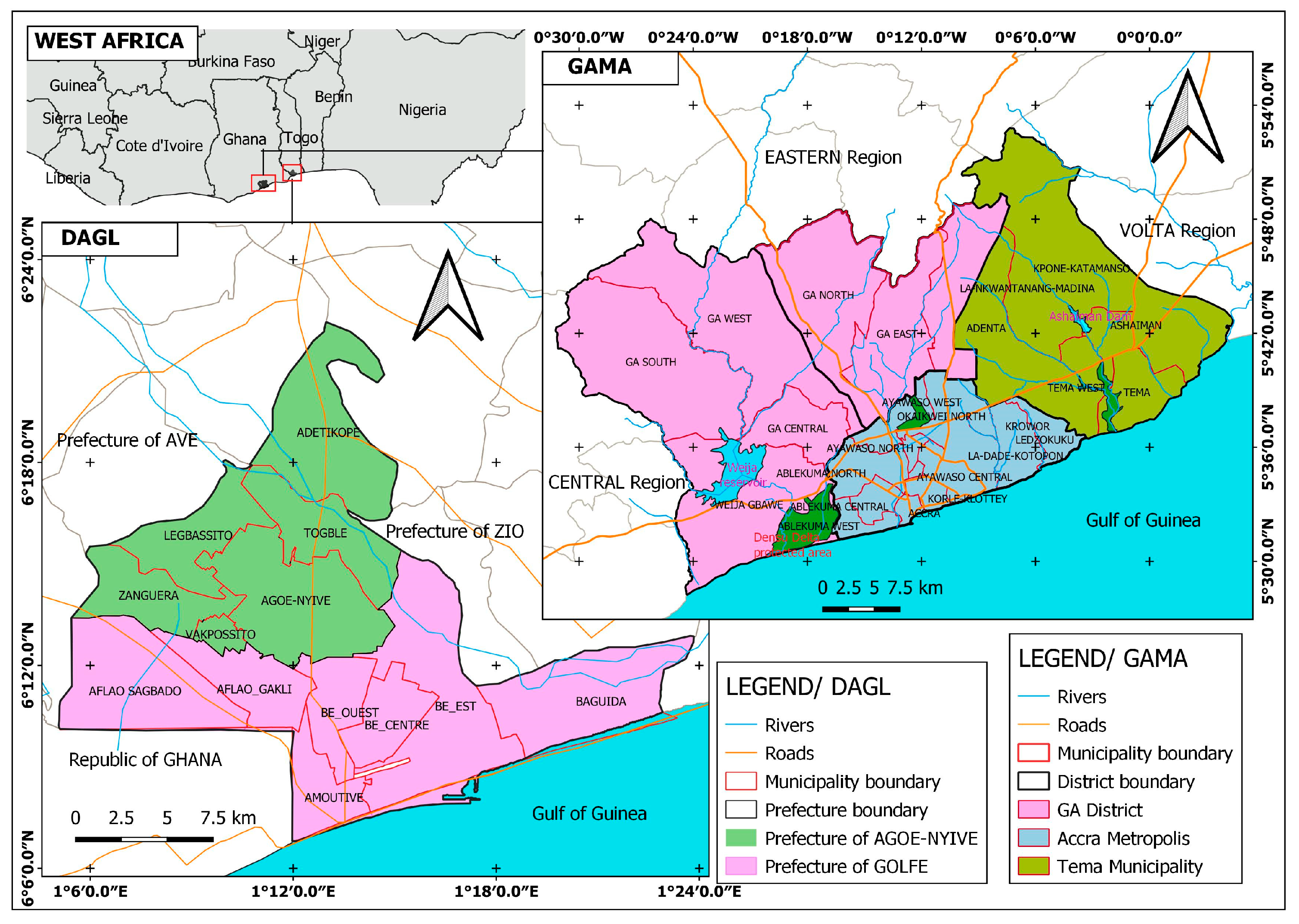
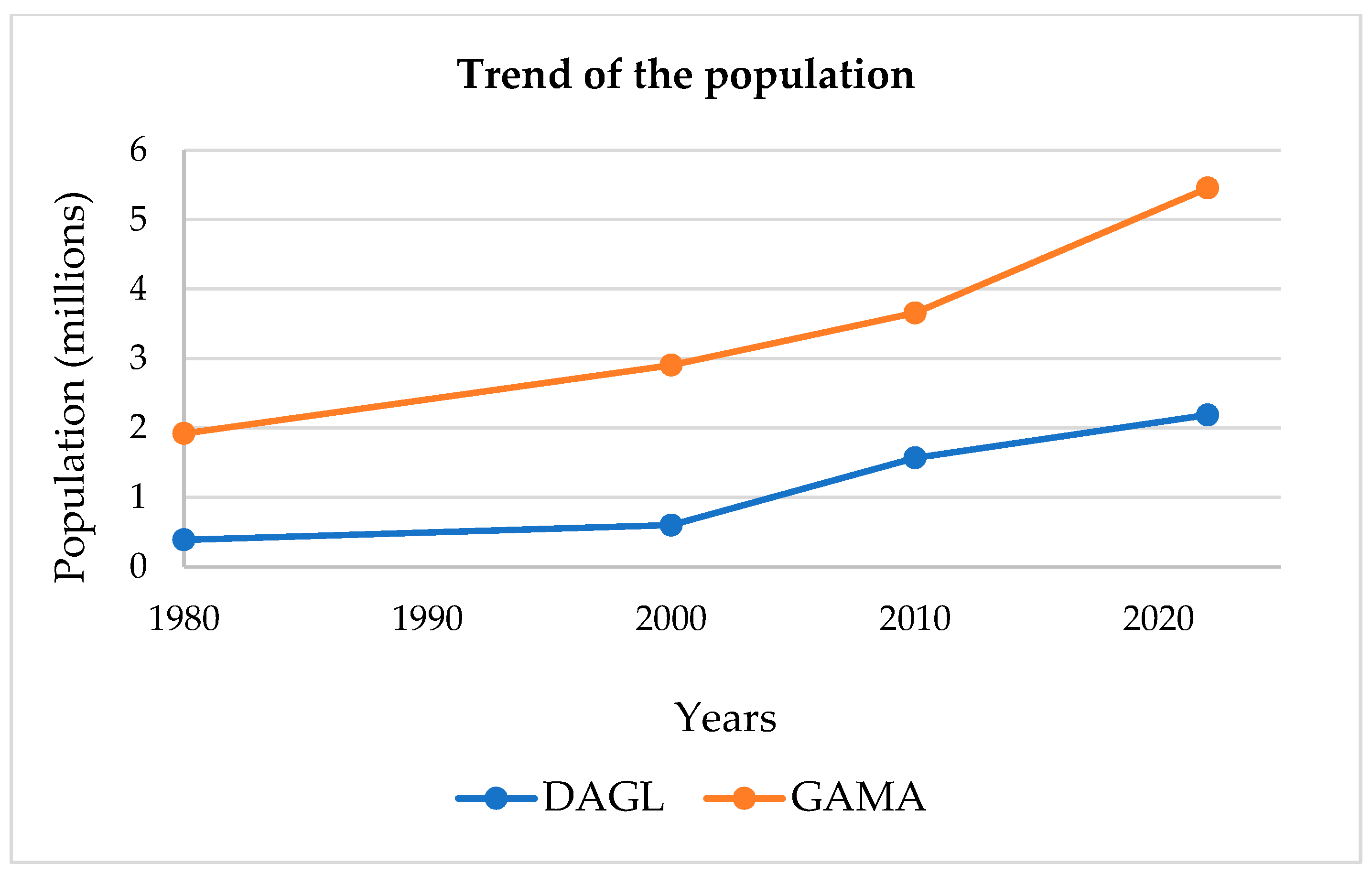
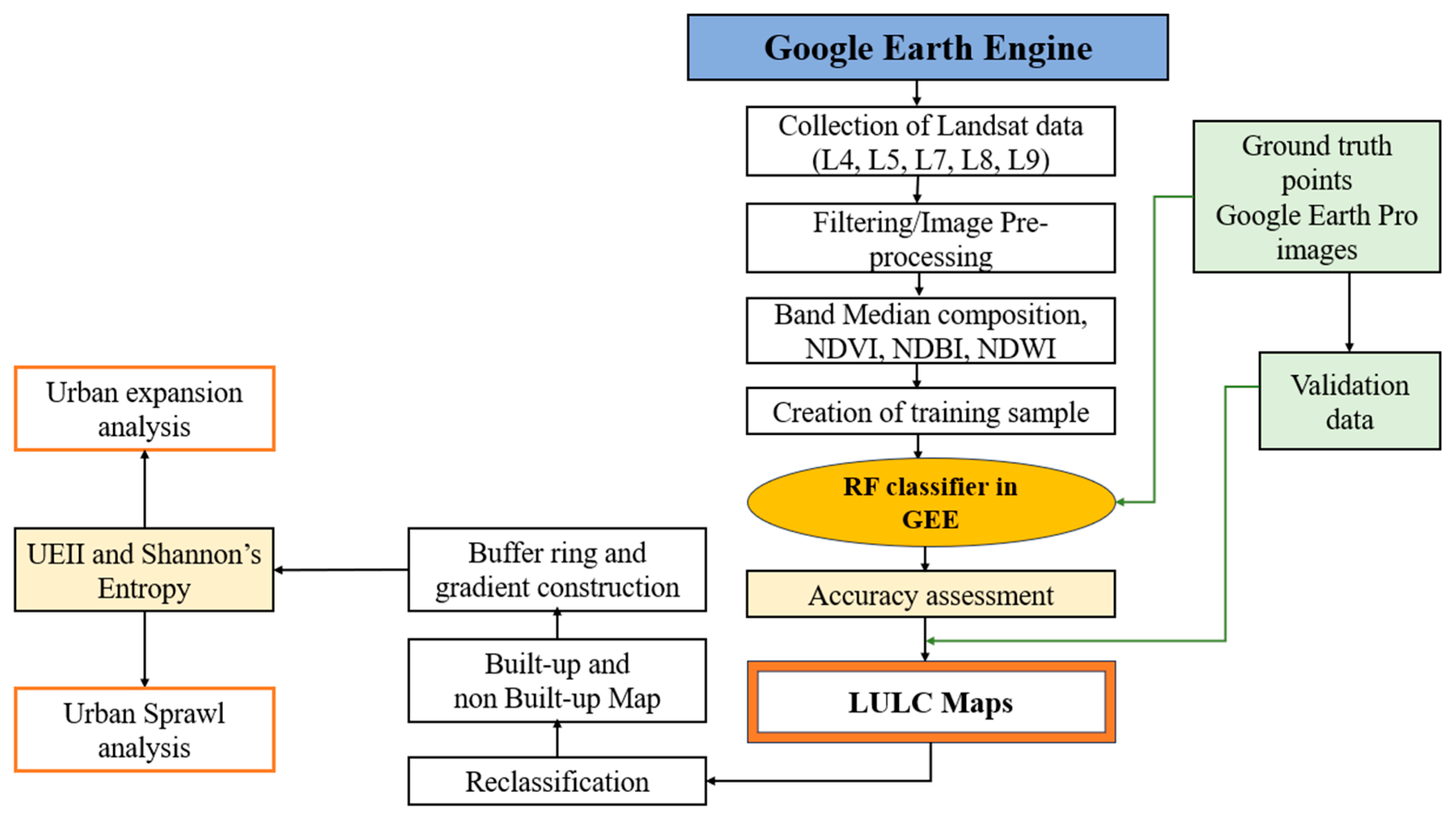
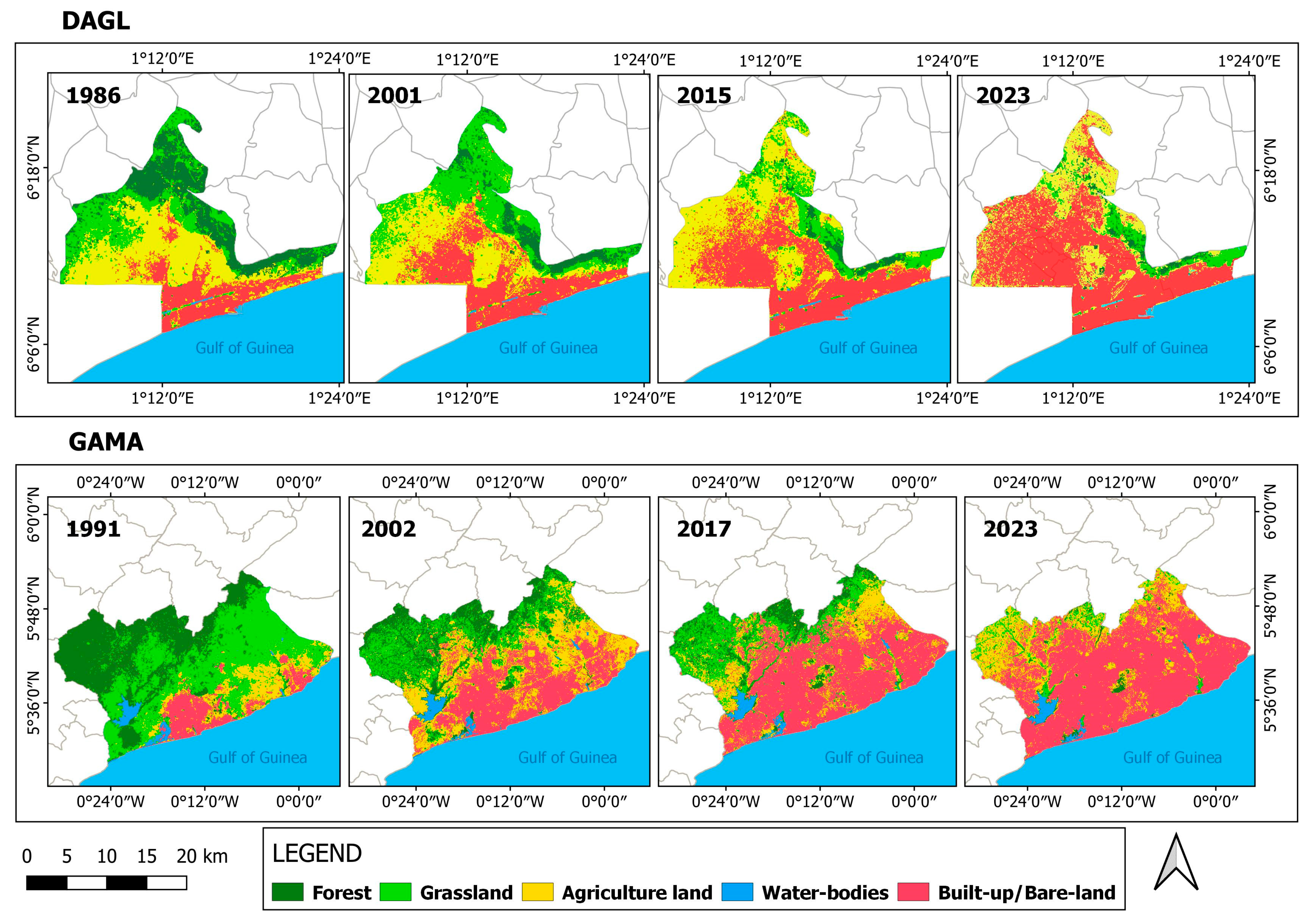

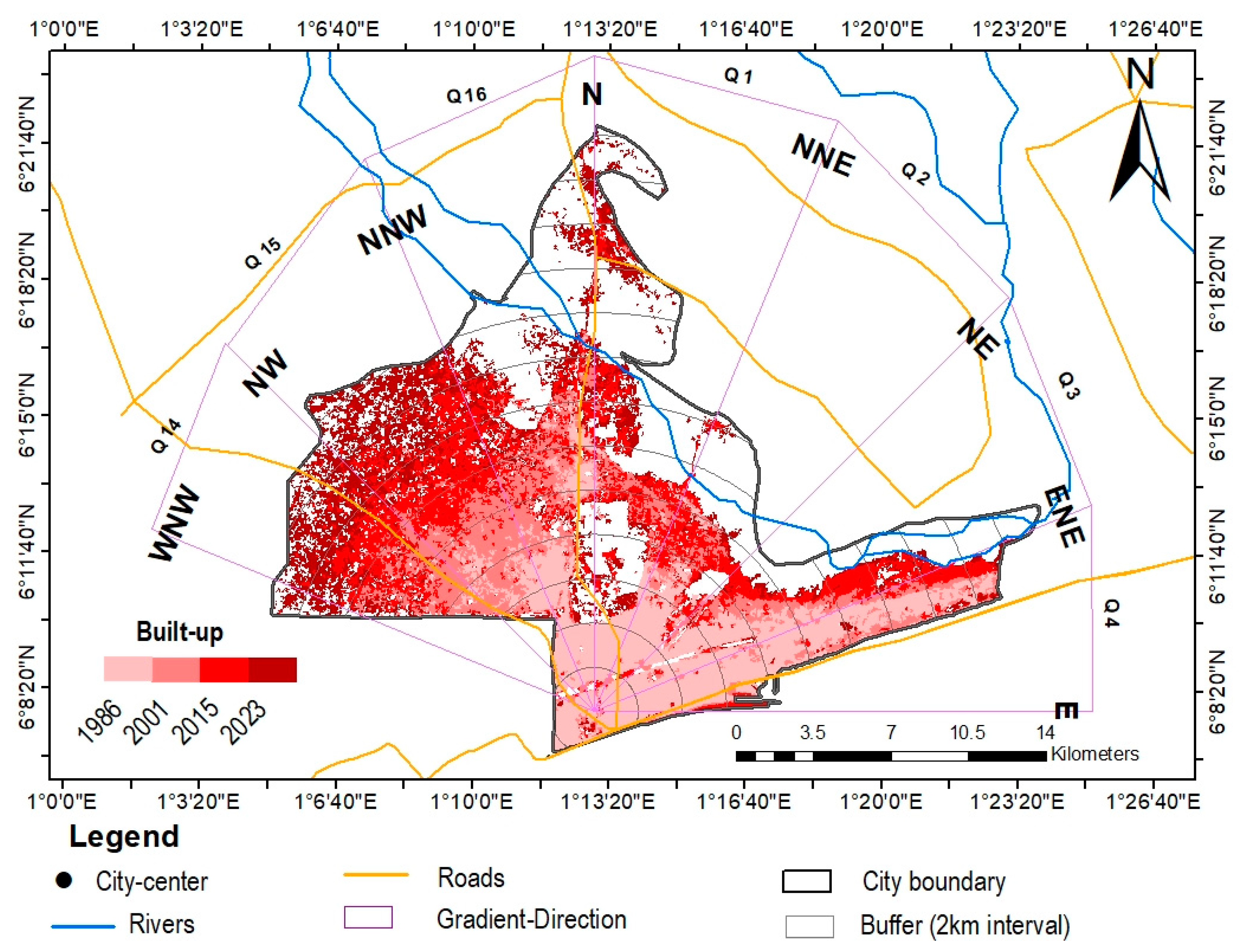
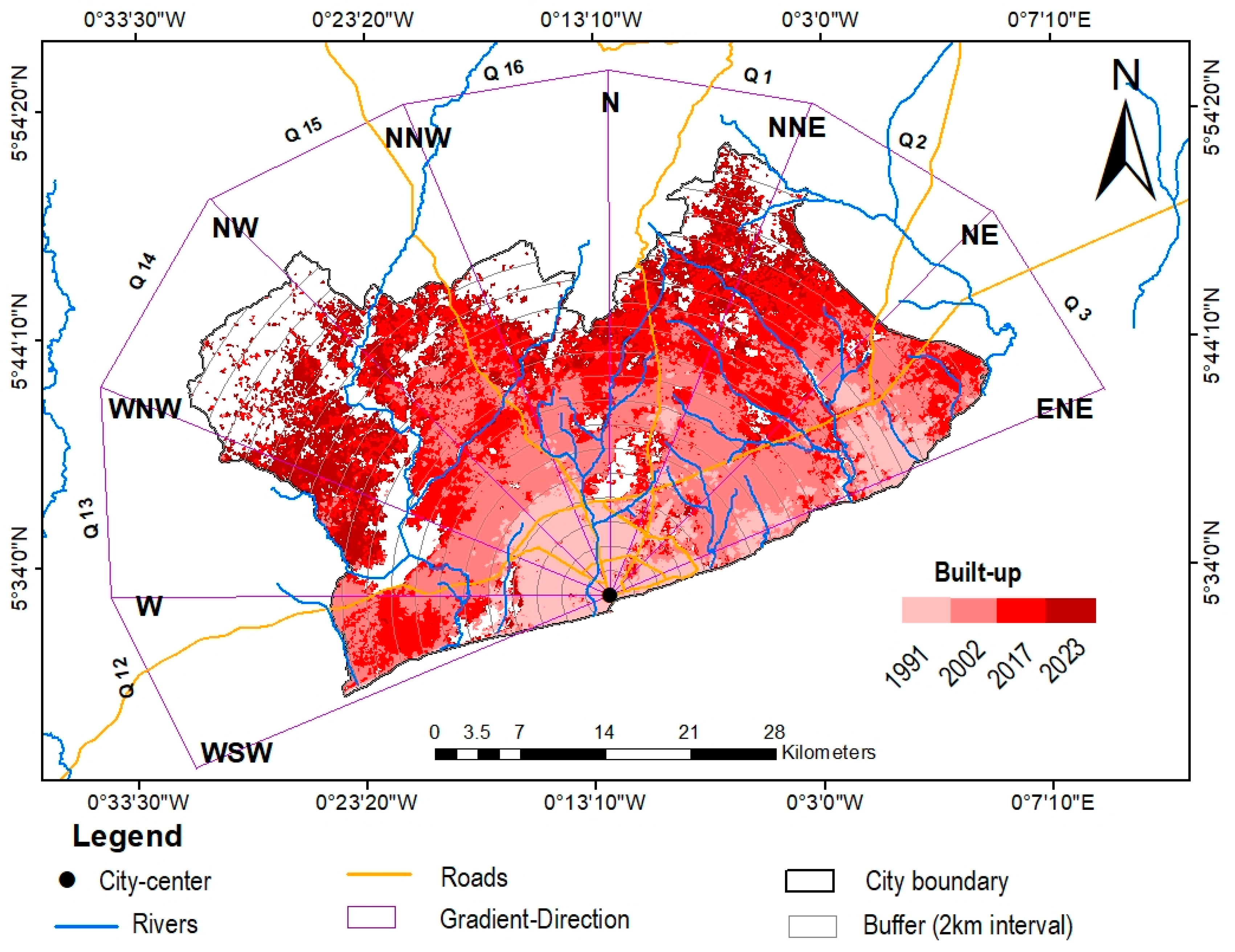
| Area | Satellite | Sensor | Spatial Resolution | Date |
|---|---|---|---|---|
| District Autonome du Grand Lomé (DAGL) | Landsat 5 | TM | 30 m | 1986 |
| Landsat 7 | ETM+ | 30 m | 2001 | |
| Landsat 8 | OLI/TIRS | 30 m | 2015 | |
| Landsat 8 | OLI/TIRS | 30 m | 2023 | |
| Greater Accra Metropolitan Area (GAMA) | Landsat 4 | TM | 30 m | 1991 |
| Landsat 7 | ETM+ | 30 m | 2002 | |
| Landsat 7 | ETM+ | 30 m | 2017 | |
| Landsat 9 | OLI/TIRS | 30 m | 2023 |
| LULC Types | Description |
|---|---|
| Forest | Forest reserves, Land dominated by trees |
| Grassland | Mixed grassland with scatter trees, herbaceous vegetation, shrubs, gardens, parks |
| Agricultural land | Irrigated and rainfed croplands, plantations, pastures |
| Built-up/Bare land | Residential, industrial, and commercial units, highways and transportation, power and communications facilities, lands with exposed soil surface, exposed rock, quarries and gravel pits |
| Water bodies | Lakes, rivers, streams, canals, reservoirs, lagoons |
| Land Cover Type | Area (km2) | Absolute Change (km2) | Average Annual Rate of Change (%) | |||||||||
|---|---|---|---|---|---|---|---|---|---|---|---|---|
| 1986 | 2001 | 2015 | 2023 | 1986–2001 | 2001–2015 | 2015–2023 | 1986– 2023 | 1986–2001 | 2001–2015 | 2015–2023 | 1986–2023 | |
| Forest | 92.31 (24.04%) | 32.34 (8.42%) | 15.42 (4.01%) | 13.17 (3.43%) | −59.96 | −16.93 | −2.25 | −79.14 | −4.33 | −3.74 | −1.82 | −2.32 |
| Grassland | 84.81 (22.09%) | 106.52 (27.74%) | 47.40 (12.34%) | 28.32 (7.38%) | 21.70 | −59.12 | −19.07 | −56.49 | 1.71 | −3.96 | −5.03 | −1.80 |
| Agriculture land | 135.78 (35.36%) | 125.44 (32.66%) | 150.36 (39.15) | 104.15 (27.12%) | −10.33 | 24.92 | 46.22 | −31.63 | −0.51 | 1.42 | −3.84 | −0.63 |
| Water bodies | 2.56 (0.67%) | 1.81 (0.47%) | 2.12 (0.55%) | 1.21 (0.32%) | 0.74 | 0.31 | −0.91 | −1.34 | −1.94 | 1.21 | −5.35 | −1.42 |
| Built-up/Bare land | 68.58 (17.86%) | 117.93 (30.71%) | 168.76 (43.94%) | 237.16 (61.67%) | 49.35 | 50.83 | 68.40 | 168.58 | 4.80 | 3.08 | 5.07 | 6.64 |
| Land Cover Type | Area (km2) | Absolute Change (km2) | Average Annual Rate of Change (%) | |||||||||
|---|---|---|---|---|---|---|---|---|---|---|---|---|
| 1991 | 2002 | 2017 | 2023 | 1991–2002 | 2002–2017 | 2017–2023 | 1991–2023 | 1991–2002 | 2002–2017 | 2017–2023 | 1991–2023 | |
| Forest | 511.78 (34%) | 304.15 (20%) | 150.50 (10%) | 36.45 (2%) | −207.62 | −153.65 | −114.05 | −475.33 | −3.69 | −3.37 | −12.63 | −2.90 |
| Grassland | 622.57 (42%) | 259.54 (17%) | 247.80 (16%) | 58.13 (4%) | −363.03 | −11.74 | −189.66 | −564.44 | −5.30 | −0.30 | −12.76 | −2.83 |
| Agriculture land | 176.84 (12%) | 439.38 (29%) | 285.91 (19%) | 321.69 (21%) | 262.54 | −153.48 | 35.78 | 144.85 | 13.50 | −2.33 | 2.09 | 2.56 |
| Water bodies | 33.86 (2%) | 32.92 (2%) | 33.73 (2%) | 30.92 (2%) | −0.93 | 0.81 | −2.81 | −2.94 | −0.25 | 0.16 | −1.39 | −0.27 |
| Built-up/Bare land | 152.23 (10%) | 461.28 (31%) | 779.34 (52%) | 1050.09 (70%) | 309.05 | 318.06 | 270.75 | 897.86 | 18.46 | 4.60 | 5.79 | 18.43 |
| Years | User Accuracy (%) | Producer Accuracy (%) | Overall Accuracy (%) | ||||||||
|---|---|---|---|---|---|---|---|---|---|---|---|
| Water | Blt/Brl | Frs | Gras | Agric | Water | Blt/Brl | Frs | Gras | Agric | ||
| 1986 | 100 | 90 | 89 | 89 | 91 | 100 | 85 | 94 | 87 | 88 | 90.12 |
| 2001 | 96 | 96 | 88 | 92 | 89 | 100 | 97 | 86 | 88 | 92 | 91.36 |
| 2015 | 97 | 98 | 91 | 91 | 90 | 100 | 99 | 86 | 86 | 96 | 93.94 |
| 2023 | 98 | 97 | 92 | 92 | 95 | 100 | 100 | 93 | 86 | 93 | 95.59 |
| Years | User Accuracy (%) | Producer Accuracy (%) | Overall Accuracy (%) | ||||||||
|---|---|---|---|---|---|---|---|---|---|---|---|
| Water | Blt/Brl | Frs | Gras | Agric | Water | Blt/Brl | Frs | Gras | Agric | ||
| 1991 | 99 | 94 | 91 | 90 | 91 | 100 | 95 | 91 | 90 | 90 | 91.36 |
| 2002 | 98 | 97 | 93 | 96 | 94 | 100 | 99 | 93 | 91 | 96 | 95.13 |
| 2017 | 100 | 99 | 96 | 95 | 94 | 100 | 100 | 91 | 88 | 99 | 96.47 |
| 2023 | 99 | 99 | 94 | 94 | 96 | 100 | 99 | 100 | 95 | 92 | 97.34 |
| Quadrants | Built-Up Area (km2) | Difference in Area (km2) | Urban Expansion Intensity Index UEII (%) | |||||||
|---|---|---|---|---|---|---|---|---|---|---|
| 1986 | 2001 | 2015 | 2023 | 1986–2001 | 2001–2015 | 2015–2023 | 1986–2001 | 2001–2015 | 2015–2023 | |
| Q1 | 4.78 | 8.30 | 15.41 | 26.29 | 3.52 | 7.10 | 10.89 | 0.34 | 0.72 | 1.94 |
| Q2 | 7.97 | 10.65 | 15.94 | 17.82 | 2.68 | 5.28 | 1.88 | 0.54 | 1.14 | 0.71 |
| Q3 | 10.93 | 14.89 | 22.46 | 25.11 | 3.96 | 7.57 | 2.65 | 0.57 | 1.18 | 0.72 |
| Q4 | 21.34 | 26.51 | 29.81 | 31.54 | 5.16 | 3.30 | 1.73 | 1.04 | 0.71 | 0.66 |
| Q14 | 1.06 | 8.89 | 16.87 | 32.52 | 7.83 | 7.98 | 15.65 | 1.24 | 1.36 | 4.66 |
| Q15 | 6.51 | 19.87 | 33.48 | 52.82 | 13.36 | 13.61 | 19.34 | 1.44 | 1.57 | 3.90 |
| Q16 | 10.90 | 22.77 | 28.66 | 42.87 | 11.87 | 5.90 | 14.20 | 0.92 | 0.49 | 2.06 |
| Quadrants | Built-Up Area (km2) | Difference in Area (km2) | UEII (%) | |||||||
|---|---|---|---|---|---|---|---|---|---|---|
| 1991 | 2002 | 2017 | 2023 | 1991–2002 | 2002–2017 | 2017–2023 | 1991–2002 | 2002–2017 | 2017–2023 | |
| Q1 | 11.16 | 35.30 | 80.57 | 136.84 | 24.15 | 45.26 | 56.28 | 1.04 | 1.43 | 4.45 |
| Q2 | 7.48 | 59.49 | 131.40 | 168.29 | 52.01 | 71.91 | 36.89 | 2.21 | 2.24 | 2.88 |
| Q3 | 39.32 | 134.69 | 188.20 | 202.29 | 95.37 | 53.51 | 14.09 | 4.00 | 1.64 | 1.08 |
| Q12 | 12.75 | 32.23 | 62.95 | 73.81 | 19.47 | 30.73 | 10.86 | 2.04 | 2.36 | 2.09 |
| Q13 | 12.87 | 39.85 | 50.03 | 83.34 | 26.99 | 10.18 | 33.31 | 2.01 | 0.56 | 4.55 |
| Q14 | 17.96 | 41.48 | 75.67 | 132.55 | 23.51 | 34.19 | 56.88 | 0.75 | 0.80 | 3.34 |
| Q15 | 18.33 | 53.97 | 101.31 | 141.35 | 35.64 | 47.33 | 40.04 | 1.69 | 1.64 | 3.48 |
| Q16 | 13.14 | 38.17 | 64.45 | 84.96 | 25.03 | 26.28 | 20.51 | 1.61 | 1.24 | 2.41 |
Disclaimer/Publisher’s Note: The statements, opinions and data contained in all publications are solely those of the individual author(s) and contributor(s) and not of MDPI and/or the editor(s). MDPI and/or the editor(s) disclaim responsibility for any injury to people or property resulting from any ideas, methods, instructions or products referred to in the content. |
© 2025 by the authors. Licensee MDPI, Basel, Switzerland. This article is an open access article distributed under the terms and conditions of the Creative Commons Attribution (CC BY) license (https://creativecommons.org/licenses/by/4.0/).
Share and Cite
Tossoukpe, A.Y.; Dukiya, J.; Folega, F.; Thiel, M.; Okhimamhe, A.A. Dynamics of Changes in Spatial Patterns of Built-Up Areas in Two Metropolitan Areas of Grand Lomé and Greater Accra (West Africa). Urban Sci. 2025, 9, 84. https://doi.org/10.3390/urbansci9030084
Tossoukpe AY, Dukiya J, Folega F, Thiel M, Okhimamhe AA. Dynamics of Changes in Spatial Patterns of Built-Up Areas in Two Metropolitan Areas of Grand Lomé and Greater Accra (West Africa). Urban Science. 2025; 9(3):84. https://doi.org/10.3390/urbansci9030084
Chicago/Turabian StyleTossoukpe, Adjowa Yéwa, Jaiye Dukiya, Fousseni Folega, Michael Thiel, and Appollonia Aimiosino Okhimamhe. 2025. "Dynamics of Changes in Spatial Patterns of Built-Up Areas in Two Metropolitan Areas of Grand Lomé and Greater Accra (West Africa)" Urban Science 9, no. 3: 84. https://doi.org/10.3390/urbansci9030084
APA StyleTossoukpe, A. Y., Dukiya, J., Folega, F., Thiel, M., & Okhimamhe, A. A. (2025). Dynamics of Changes in Spatial Patterns of Built-Up Areas in Two Metropolitan Areas of Grand Lomé and Greater Accra (West Africa). Urban Science, 9(3), 84. https://doi.org/10.3390/urbansci9030084







